 |
Home | Charity | Feedback |
Guatemala:
Antigua,
Lake Atitlan,
Tikal
Tikal, Guatemala: The Mayan Civilisation by Prakash Bang, Editor in Chief 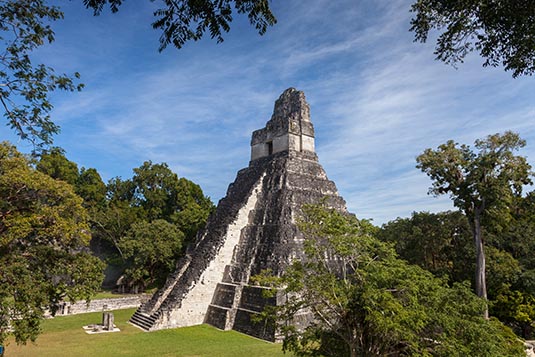 Archeologists estimate that the Maya settled in the area now known as Tikal in about 900 BC. Tikal National Park encompasses 575 square kilometres of jungle and thousands of ruined structures. The central part of the ancient city alone contains 3,000 buildings and covers about 16 square kilometers. 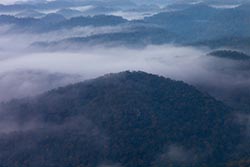 Exploring Central America, our group arrived late evening in Guatemala City by a charter flight from Managua, Nicaragua. The 1-hour flight offered spectacular views of the landscape below. Our local guide was waiting for us at the airport.
Exploring Central America, our group arrived late evening in Guatemala City by a charter flight from Managua, Nicaragua. The 1-hour flight offered spectacular views of the landscape below. Our local guide was waiting for us at the airport.
For the night we were booked at Westin Camino Real. The hotel is one of the top business hotels in Guatemala City and is located in the lively and safe Zone 10 area of Guatemala City, quite close to the airport. The hotel has luxurious common areas decorated in marble including a large restaurant, lounge areas and bar. The hotel also has a casino, albeit only with electronic slot machines. 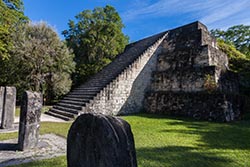 That evening, our service provider, Viaventure, had organised a lovely sit-down dinner at the hotel itself. Thereafter few from the group planned to spend the night, literally, at the casino while the others decided to call it a day. After all, the next morning we had to leave at 4:30 in the morning to catch our flight to Flores. From Flores airport, a bus would take us to Tikal that was about 60 kms. away.
That evening, our service provider, Viaventure, had organised a lovely sit-down dinner at the hotel itself. Thereafter few from the group planned to spend the night, literally, at the casino while the others decided to call it a day. After all, the next morning we had to leave at 4:30 in the morning to catch our flight to Flores. From Flores airport, a bus would take us to Tikal that was about 60 kms. away.
Our return flight from Flores to Guatemala City was scheduled in the evening. Leaving aside the travelling time of about 2 hours for the to and fro journey to Tikal and back, we had about 3-4 hours on hand to explore the lost civilisation. The bus dropped us at the visitor centre. For the serious visitor, it would take days to explore the ancient city. For tourists like us a few hours is just fine - to explore the main squares and temples. Carrying a hat and water is definitely a good idea. Comfortable walking shoes is also a must. 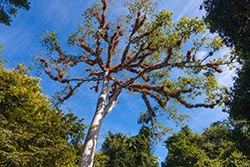 Since time was limited, we focused on the Grand Square, Square of the Great Pyramid and Square of the Seven Temples. Our guide did a good job to give us a brief about various structures as also a bit of the Mayan Calendar.
Since time was limited, we focused on the Grand Square, Square of the Great Pyramid and Square of the Seven Temples. Our guide did a good job to give us a brief about various structures as also a bit of the Mayan Calendar.
The most striking feature of Tikal is its towering, steep-sided temples, rising to heights of more than 44m, but what distinguishes it is its jungle setting. Its many plazas have been cleared of trees and vines, its temples uncovered and partially restored, but as you walk from one building to another you pass beneath the dense canopy of rainforest amid the rich, loamy aromas of earth and vegetation. Much of the delight of touring the site comes from strolling the broad causeways, originally built from packed limestone to accommodate traffic between temple complexes. 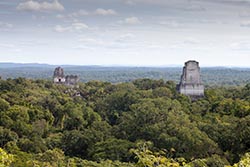 Tikal grew into an important ceremonial, cultural, and commercial centre over the centuries. Most of the city's huge temples were constructed during the eighth century AD when Tikal became the greatest city in the Maya world with a population of around 100,000.
Tikal grew into an important ceremonial, cultural, and commercial centre over the centuries. Most of the city's huge temples were constructed during the eighth century AD when Tikal became the greatest city in the Maya world with a population of around 100,000.
Tikal fell into decline at the end of the ninth century and was virtually abandoned. The causes of the Maya empire's collapse remain a mystery, but wars, famine, overpopulation and resource depletion have all been blamed. Tikal's great stone monuments languished for centuries and were gradually reclaimed by the jungle. Hernan Cortes, the conqueror of Mexico, and his motley band of conquistadors marched by Tikal in 1525, but they failed to see its temples concealed by 40-metre-tall silk, cotton, cedar and mahogany trees. 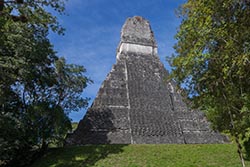 From atop Tikal's pyramids, Maya astronomers tracked the movements of Venus and all the other visible planets. They used complex calculations - extremely accurate even by today's standards - to fine tune their very own calendar, which can be compared to a system of interlocking gears made up of a 260-day calendar known as the tzolkin that meshed with a 365-day solar calendar to complete 52-year cycles.
From atop Tikal's pyramids, Maya astronomers tracked the movements of Venus and all the other visible planets. They used complex calculations - extremely accurate even by today's standards - to fine tune their very own calendar, which can be compared to a system of interlocking gears made up of a 260-day calendar known as the tzolkin that meshed with a 365-day solar calendar to complete 52-year cycles.
As we had to manage our own tight calendar, it was time to head back to Guatemala City. The next morning, after breakfast, we would drive to Antigua. Tikal Image Gallery  Photo viewer Photo viewer
|
|
|
Home |
Charity |
Feedback
Privacy Policy | Terms of Usage © YoGoYo.com. All rights reserved. |





























